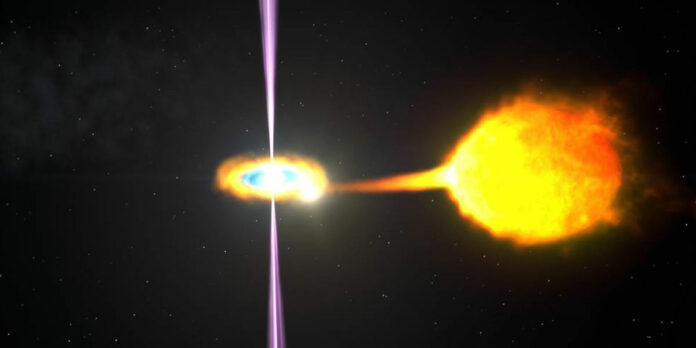HUNTSVILLE — In February, NASA’s Imaging X-ray Polarimetry Explorer (IXPE) observed its first accreting neutron star: Hercules X-1, more than 21,000 light years from Earth. Now a new study based on those observations has upended traditional assumptions about neutron stars and the interior processes that drive these ultra-powerful objects.
“The findings were unexpected,” said Steve Ehlert, an astrophysicist at NASA’s Marshall Space Flight Center in Huntsville. “There’s a lot of surprised and excited head-scratching going on right now in regard to this neutron star.”
The study, published in the Oct. 24 issue of the journal Nature Astronomy, is a step toward solving longstanding mysteries about these dense, spinning, undead phenomena.
Hercules X-1 isn’t alone in space. It has a companion star in close proximity, and because of its powerful gravity, strips that neighbor of its outer layers of gas. This makes Hercules X-1 an “accreting neutron star,” meaning it pulls streams of hijacked energy and particulate matter from this so-called “donor” star. The material is dragged along the neutron star’s own intense magnetic field lines, and forms an accretion disk around Hercules X-1.
Neutron stars in a binary system such as Hercules X-1 are the result of massive stars that have gone supernova. The cataclysmic release of energy shrinks them dramatically, sometimes to just 10-12 miles in diameter. They remain incredibly dense, with a mass roughly one and a half or two times that of the sun and a magnetic field trillions of times that of Earth.
Hercules X-1 is also a pulsar. Pulsars are neutron stars which rotate faster and faster as their cores collapse, emitting powerful beams of electromagnetic radiation from their poles. These energetic strobes register as “pulses,” detectable across distances of thousands of light-years by IXPE and other telescopes.
Scientists know a lot about the strength of a neutron star’s magnetic field, Ehlert said, but have yet to fully grasp the physical structure of that field, how and why it fluctuates over time, and the relationship between accreting neutron star and its donor star.
“That’s where IXPE really shines,” said Brian Ramsey, IXPE principal investigator at Marshall. “The effects we infer from polarization are impossible to see directly, operating on scales we could never hope to capture using conventional means. IXPE is helping us document the behavior of the invisible world.”
IXPE builds on the discoveries of NASA’s Chandra X-ray Observatory and other space telescopes by measuring the polarization of X-ray light. Polarization is a property of light that tells us about the interconnected electric and magnetic fields that make up all wavelengths of light. These fields interact to create oscillation, or vibration, at right angles to the light’s path of travel. When its electric fields vibrate in a single, unified direction, we say the light is polarized.
“IXPE is a new and novel set of measurements in a complex system which helps us understand that system better than we’ve ever done before,” Ramsey said.
“What excites me most is the chance to gain new understanding of the big questions IXPE can help us answer – how neutron stars and black holes fire off such high-energy particles,” Ehlert said. “That’s not an easy thing, even in such extreme space environments.”
Don’t miss out! Subscribe to our email newsletter to have all our smart stories delivered to your inbox.



